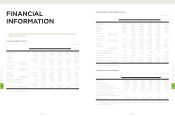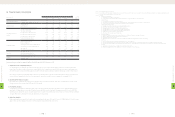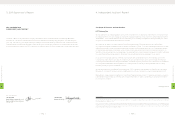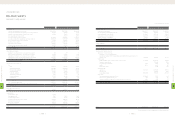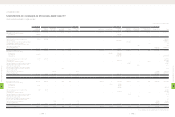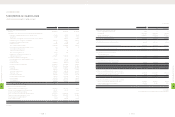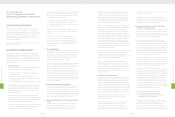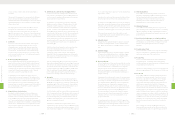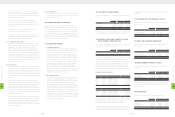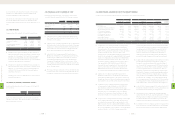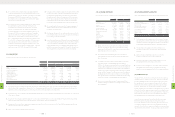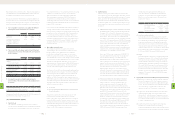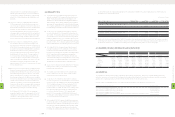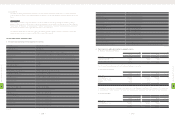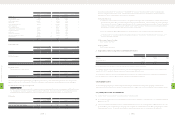HTC 2011 Annual Report Download - page 79
Download and view the complete annual report
Please find page 79 of the 2011 HTC annual report below. You can navigate through the pages in the report by either clicking on the pages listed below, or by using the keyword search tool below to find specific information within the annual report.
- 3 to 5 years; transportation equipment - 5 years; and leasehold
improvements - 3 years.
Properties still in use beyond their original estimated useful lives
are further depreciated over their newly estimated useful lives.
The related cost (including revaluation increment) accumulated
depreciation, accumulated impairment losses and any unrealized
revaluation increment are derecognized from the balance sheet
upon property disposal. Any gain or loss on disposal of the asset
is included in nonoperating gains or losses in the year of disposal.
If the properties are leased to others, the related costs and
accumulated depreciation would be transferred from properties
to other assets - assets leased to others.
12. Intangible Assets
Intangible assets acquired are initially recorded at cost and are
amortized on a straight-line basis over their estimated useful
lives. Patents are amortized on a straight-line basis over 5 to 10
years.
13. Deferred Charges
Deferred charges are telephone installation charges, computer
software costs and deferred license fees. Installation charges
and computer software are amortized on a straight-line basis
over 3 years, and deferred license fees, over 10 years.
14. Asset Impairment
If the recoverable amount of an asset is estimated to be less than
its carrying amount, the carrying amount of the asset is reduced
to its recoverable amount. An impairment loss is charged to
earnings unless the asset is carried at a revalued amount, in
which case the impairment loss is treated as a deduction to
the unrealized revaluation increment and any remaining loss is
charged to earnings.
If an impairment loss subsequently reverses, the carrying amount
of the asset is increased accordingly, but the increased carrying
amount may not exceed the carrying amount that would have
been determined had no impairment loss been recognized for
the asset in prior years. A reversal of an impairment loss is
recognized in earnings, unless the asset is carried at a revalued
amount, in which case the reversal of the impairment loss is first
recognized as gains to the extent that an impairment loss on
the same revalued asset was previously charged to earnings.
Any excess amount is treated as an increase in the unrealized
revaluation increment. A reversal of an impairment loss on
goodwill is disallowed.
For long-term equity investments on which the Company has
significant influence but over which the Company has no control,
the carrying amount (including goodwill) of each investment is
compared with its own recoverable amount for the purpose of
impairment testing.
15. Marketing Expenses
The Company accrues marketing expenses on the basis of
agreements, management's judgment, and any known factors
that would significantly affect the accruals. In addition,
depending on the nature of relevant events, the accrued
marketing expenses are accounted for as an increase in
marketing expenses or as a decrease in revenues.
16. Warranty Provisions
The Company provides warranty service for one year to two
years depending on the contract with customers. The warranty
liability is estimated on the basis of management's evaluation
of the products under warranty, past warranty experience, and
pertinent factors.
17. Provisions for Contingent Loss on Purchase Orders
The provision for contingent loss on purchase orders is estimated
after taking into account the effects of changes in the product
market, in inventory management and in the Company's
purchases.
18. Product-related Costs
The cost of products consists of costs of goods sold, warranty
expenses, contingent loss on purchase orders, and inventory
write-downs and reversal of these write-downs.
19. Pension Plan
Pension cost under a defined benefit plan is determined by
actuarial valuations. Contributions made under a defined
contribution plan are recognized as pension cost during the year
in which employees render services.
Curtailment or settlement gains or losses on the defined benefit
plan are recognized as part of the net pension cost for the year.
20
. Income Tax
The Company applies the intra-year and inter-year allocation
methods to its income tax, whereby (1) a portion of income
tax expense is allocated to the cumulative effect of changes
in accounting principles or charged or credited directly to
stockholders' equity; and (2) deferred income tax assets and
liabilities are recognized for the tax effects of temporary
differences, unused loss carryforward and unused tax credits.
Valuation allowances are provided to the extent, if any, that it is
more likely than not that deferred income tax assets will not be
realized. A deferred income tax asset or liability is classified as
current or noncurrent in accordance with the classification of its
related asset or liability. However, if a deferred income tax asset
or liability does not relate to an asset or liability in the financial
statements, then it is classified as either current or noncurrent
based on the expected length of time before it is realized or
settled.
If the Company can control the timing of the reversal of a
temporary difference arising from the difference between the
book value and the tax basis of a long-term equity investment
or local economic conditions that correlate with defaults on
receivables.
The amount of the impairment loss recognized is the difference
between the asset carrying amount and the present value of
estimated future cash flows, after taking into account the related
collateral and guarantees, discounted at the receivable's original
effective interest rate.
The carrying amount of the accounts receivable is reduced
through the use of an allowance account. When accounts
receivable are considered uncollectible, they are written off
against the allowance account. Recoveries of amounts previously
written off are credited to the allowance account. Changes in the
carrying amount of the allowance account are recognized as bad
debt in profit or loss.
7. Inventories
Inventories consist of raw materials, supplies, finished goods
and work-in-process and are stated at the lower of cost or
net realizable value. Inventory write-downs are made item
by item, except where it may be appropriate to group similar
or related items. Net realizable value is the estimated selling
price of inventories less all estimated costs of completion and
costs necessary to make the sale. Cost is determined using the
moving-average method.
8. Held-to-maturity Financial Assets
Held-to-maturity financial assets are carried at amortized cost
using the effective interest method. Held-to-maturity financial
assets are initially measured at fair value plus transaction costs
that are directly attributable to the acquisition. Profit or loss is
recognized when the financial assets are derecognized, impaired,
or amortized. All regular way purchases or sales of financial
assets are accounted for using a trade date basis.
An impairment loss is recognized when there is objective
evidence that the investment is impaired. The impairment loss
is reversed if an increase in the investment's recoverable amount
is due to an event which occurred after the impairment loss
was recognized; however, the adjusted carrying amount of the
investment may not exceed the carrying amount that would have
been determined had no impairment loss been recognized for
the investment in prior years.
9. Financial Assets Carried at Cost
Investments in equity instruments with no quoted prices in
an active market and with fair values that cannot be reliably
measured, such as non-publicly traded stocks and stocks traded
in the emerging stock market, are measured at their original
cost. The accounting treatment for dividends on financial assets
carried at cost is similar to that for dividends on available-for-sale
financial assets. An impairment loss is recognized when there is
objective evidence that the asset is impaired. A reversal of this
impairment loss is disallowed.
10. Investments Accounted for by the Equity Method
Investments in which the Company holds 20 percent or more
of the investees' voting shares or exercises significant influence
over the investees' operating and financial policy decisions are
accounted for by the equity method.
The acquisition cost is allocated to the assets acquired and
liabilities assumed on the basis of their fair values at the date
of acquisition, and the acquisition cost in excess of the fair
value of the identifiable net assets acquired is recognized as
goodwill. Goodwill is not being amortized. The fair value of the
net identifiable assets acquired in excess of the acquisition cost
is used to reduce the fair value of each of the noncurrent assets
acquired (except for financial assets other than investments
accounted for by the equity method, noncurrent assets held
for sale, deferred income tax assets, prepaid pension or other
postretirement benefit) in proportion to the respective fair values
of the noncurrent assets, with any excess recognized as an
extraordinary gain.
Profits from downstream transactions with an equity-method
investee are eliminated in proportion to the Company's
percentage of ownership in the investee; however, if the
Company has control over the investee, all the profits are
eliminated. Profits from upstream transactions with an equity-
method investee are eliminated in proportion to the Company's
percentage of ownership in the investee.
When the Company subscribes for its investee's newly issued
shares at a percentage different from its percentage of ownership
in the investee, the Company records the change in its equity in
the investee's net assets as an adjustment to investments, with
a corresponding amount credited or charged to capital surplus.
When the adjustment should be debited to capital surplus,
but the capital surplus arising from long-term investments is
insufficient, the shortage is debited to retained earnings.
11. Properties
Properties are stated at cost less accumulated depreciation
and accumulated impairment losses. Borrowing costs directly
attributable to the acquisition or construction of properties are
capitalized as part of the cost of those assets. Major additions
and improvements to properties are capitalized, while costs of
repairs and maintenance are expensed currently.
Assets held under capital leases are initially recognized as assets
of the Company at the lower of their fair value at the inception of
the lease or the present value of the minimum lease payments;
the corresponding liability is included in the balance sheet as
obligations under capital leases. The interest included in lease
payments is expensed when paid.
Depreciation is calculated on a straight-line basis over the
estimated service lives of the assets plus one additional year for
salvage value: buildings (including auxiliary equipment) - 3 to 50
years; machinery and equipment - 3 to 5 years; office equipment
8
FINANCIAL INFORMATION
| 154 |
8
FINANCIAL INFORMATION
| 155 |



